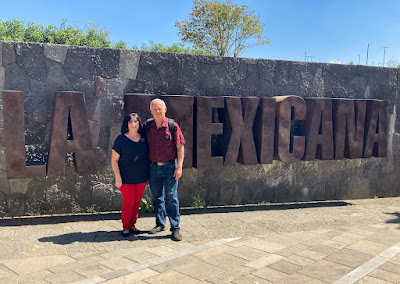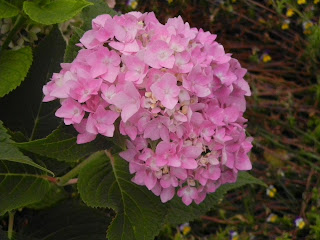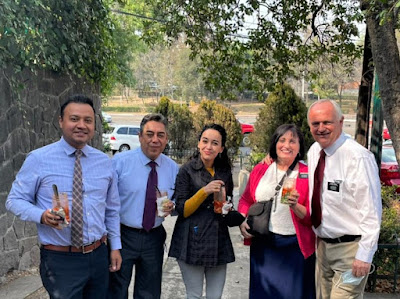
Monday was a holiday, so only the senior missionaries were
at the area offices. Ron and I spent a few hours there, and then took off with
the Deavers and went to La Mexicana Park in Santa Fe. Bob Alsop told us about
this park and said we should go see it. We didn’t get the chance to go there
with the Alsops before they left, but now we can see why he recommended it.
Santa Fe is probably the newest and most modern area of Mexico City. The park is
on a hill that sits at the base of a line of skyscrapers that have interesting
shapes and architecture to them. It is very family and pet friendly, and since
it was a holiday, it was full of people enjoying the beautiful February
weather. Along one edge of the park is a long line of restaurants, and we chose
one to eat dinner at. Santa Fe also has a beautiful mall, which Ron and I
visited when we were looking for places for the Giving Machines. We debated
walking to it, but it was about a mile and I was feeling a little off that day,
so we didn’t. That will give us another excuse to go back to Santa Fe another
day.





This week at the office I was able to get back to a project
I was working on before we got tied up with the Giving Machines and then the
Communications Seminar. The project started many months ago when Alfredo asked
me to find photos to accompany a couple of articles that were going to be in
the Mexico Area’s pages of the Liahona. The Church has a collection of
thousands of photos which we can use, but it is time consuming to comb through
all the photos looking for ones that fit the topic we need AND that look
Mexican. (Sorry, but a blue-eyed blonde family pulling into a two car garage
just doesn’t cut it in Mexico.) After finding pictures for Alfredo, I suggested
to him that Mexico needed a photo collection of its own, and offered to go
through all the Church’s photos and download the ones that will work here.
Alfredo thought it was a good idea and told me that PSD also had a lot of
photos that would be good to include. He set up a OneDrive folder for me, and I
went to work. I made subfolders with names like “Family,” “Prayer,” and
“Scriptures.” I give each photo a title that describes it but that also
includes words that someone might search for. For example, a photo might be
called, “Mother with young daughter, love, happy, smile,” (all in Spanish, of
course.) This way, if someone knows they need a photo of a family, they can
just look in the “Family” folder. But if they need something a little more
subtle, like people who are happy, they can search for “happy” or “smile” and
all the photos I’ve put those tags on will come up. Some people might find
doing this project a little tedious, but I love organizing things, so this is
right up my alley. I get really absorbed in it, and time passes quickly when
I’m working on it. I’m almost done with the Church’s collection, and then I
will work on PSD’s and ones Pat Frandsen has taken. For those, I will have the
added task of making sure we have all the proper permission forms signed so we
can use them. That will make it a little more complicated, but it will be worth
it if it makes the photos more accessible. I’m hoping this collection will be
something that will be used for years to come.

Dave Barnett’s sister and her husband came to visit. They
made reservations for a tour at a chocolate museum and invited us to go with
them. How could we turn that down? It was a small museum, but very interesting.
Chocolate comes from the bean like seeds of the cacao tree, which is native to
Mexico. The beans are roasted, and then the brittle skin that covers them has
to be removed before they are ground. They gave us some roasted beans to peel,
and as we did, the smell was wonderful! The Mayans and Aztecs made chocolate
drinks, though they didn’t use milk and sugar like we do today, so it was
probably a bit bitter. The Aztecs considered chocolate the food of the Gods and
used the cocoa beans as money. When the Spaniards came to Mexico, they started adding milk and sugar to the drink, and that is how we drink chocolate today. At the end of the tour, they had us grind some
cocoa beans using the method the Mayans and Aztecs used. It involved using a
stone slab which was heated by a fire underneath (we used sterno cans) so that
the oils in the beans came out and the ground beans became a paste rather than
a powder. After we got the beans into a paste (with a little help from the
expert at the museum) they made hot chocolate for us from it.
We added sugar and cinnamon and mixed it into
hot milk, so it wasn’t authentic Mayan. The museum had a little store attached
to it that sold--what else--chocolates! It was a
sweet day.
 |
| This is the Mayan glyph for Chocolate |
 |
| Along the bottom of this display is showed how many cacao beans it took to buy certain things. A tamal (a single tamale) cost 1, an avacado cost 2, and a turkey egg cost 100. |
 |
| When we walked into this room and I saw these cacao pods, I thought they must have been painted to get these bright colors, but they weren't! these are naturally occuring colors of the pods. |
 |
| This picture shows that the pods form on the trunks of the cacao trees. That means the flowers also grew there. I thought that was amazing! |
 |
| These are pitchers for hot chocolate. |
 |
| The museum was in an old Spanish style house which still had the original tile on the floors. |
 |
| This seashell was made from chocolate.... |
.jpg) |
| ...and so were these hands. |
 |
| These chocolate figures were ninety years old! |
 |
| This was from a video showing a woman roasting corn and cacao beans. If you look closely you will realize that her "grill" is an old wheelbarrow full of charcoal. If you happen to have an old metal wheelbarrow that you're not sure what to do with, here's a thought. |
 |
| The walls of this room were covered with Chocolate disks, which are changed every six months. |
 |
| The used disks are make into these chocolate bricks. |
 |
| The museum expert (middle) showing Ron and Dave how to grind the beans. |
 |
| Putting the chocolate paste into hot milk. |
 |
| I bought a couple of these huge chocolate turtles. I can't tell you if they're as delicious as they look because we haven't eaten them yet. I'm saving them for Valentine's Day on Tuesday--don't tell Ron. |
 |
| They sold chocolate candies in all different shapes. I got a kick out of these chocolate lips. |
Saturday morning, we and the Deavers went to the tianguis. We
rode a bus to get there. The buses often have music playing—sometimes Mexican,
sometimes American. The one we rode Saturday was blaring American hard rock. A
section of the road we took has several curves in it. The bus driver was driving
quite fast, and when he hit those curves, it literally threw two women out of
their seats. The rest of us were hanging on for dear life. Once we knew we
weren’t going to die, Vicki Deaver let out a whoop, and Ron called out (in
Spanish) “This is better than Disneyland.” That made everyone on the bus start
laughing. The song playing at that moment was from AC/DC, and the man sitting
across the isle from us looked over and in a very heavy accent said, “Highway
to Hell.” That was actually the song that was playing. That made us laugh even
more.







.jpg)























Comments
Post a Comment